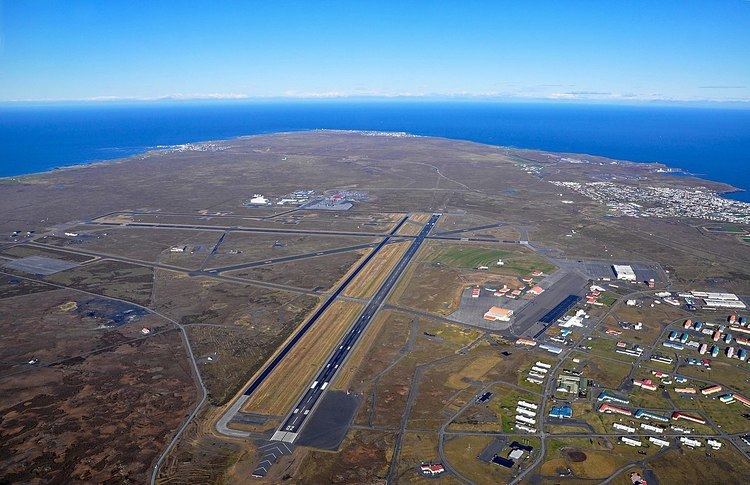Airport type Public / Military Hub for IcelandairWOW air Elevation 52 m | Location Sandgerði, Iceland Elevation AMSL 52 m / 171 ft Code KEF Municipality Reykjavik | |
 | ||
Website www.kefairport.is/english/ Profiles | ||
Keflavík International Airport (Icelandic: Keflavíkurflugvöllur) (IATA: KEF, ICAO: BIKF), also known as Reykjavík-Keflavík Airport, is the largest airport in Iceland and the country's main hub for international transportation. The airport is 1.7 nautical miles (3.1 km; 2.0 mi) west of Keflavík and 50 km (31 mi) southwest of Reykjavík. The airport has three runways, two of which are in use, and the airport area is about 25 km2 (9.7 sq mi). Most international journeys to or from Iceland pass through this airport.
Contents
The main carriers at Keflavík are Icelandair and WOW air, each of which has the airport as its main hub. The airport is almost exclusively used for international flights; most domestic flights use Reykjavík Airport, which lies 3 km (1.9 mi) from Reykjavík's city centre, although seasonal flights from Akureyri fly to Keflavík. Keflavík Airport is operated by Isavia, a government enterprise.
Early years
Originally, the airport was built by the United States military during World War II and opened on March 23, 1943. The U.S. named it Meeks Field after a young pilot, George Meeks, who died on the Reykjavík airfield. After the war, the airport and the base were returned to Iceland's control and were renamed for the nearby town of Keflavik. In 1951, the U.S. military returned to the airport under a defense agreement between Iceland and the U.S. signed on 5 May 1951. Later, Iceland joined NATO.
Development since the 1950s
With the reestablishment of the military air base at Keflavík during the 1950s, the air terminal found itself in the middle of a secure military zone. Travelers had to pass through military check points to reach their flights, until 1987, when the civilian terminal was relocated.
The presence of foreign military forces in Iceland under the NATO sponsored Iceland–U.S. Defense Agreement of 1951 was controversial in Iceland, which had no indigenous military forces other than the Icelandic Coast Guard. During the 1960s and 1970s, rallies were held to protest the U.S. military presence in Iceland (and in particular at Keflavík), and every year protesters walked the 50 km (31 mi) road from Reykjavík to Keflavík and chanted "Ísland úr NATO, herinn burt" (literally: Iceland out of NATO, the military away). The protests were not effective. One of the participants was Vigdís Finnbogadóttir, who later became the first female President of Iceland.
The former Agreed Military Area at Keflavík was re-designated "Airport, Security and Development Area" under the supervision of the Keflavík International Airport Ltd. (established 1 January 2009), the Icelandic Coast Guard and the Keflavík Airport Development Corporation (Kadeco), respectively. The Coast Guard maintains hangars for military aircraft as well as ammunition depots, air defence radars and other military equipment for national defence. The former military encampment area (U.S. Naval Air Station Keflavik) being developed by Kadeco has been named Ásbrú to reflect its new role. The airport is in the little village named Sandgerði, but the runway leads to Keflavík.
The 10,000-foot-long (3,000 m) and 200-foot-wide (61 m) runways are long enough to support NASA's Space Shuttle and also the Antonov An-225. On 29 June 1999, Concorde G-BOAA flew from Heathrow Airport to Reykjavík (Keflavík airport). The Concorde had been there earlier. The airport is also an important emergency landing runway for large aircraft in transatlantic operation in the ETOPS system, which requires aircraft to always have less than a certain distance from a suitable landing site. For many two-engine aircraft this is two or three hours with malfunction in one engine, so it would have been disallowed to cross the Atlantic ocean with many two-engine aircraft if this airport didn't exist.
Facilities
The terminal is named after Leif Erikson who was the first European to discover North America (Flugstöð Leifs Eiríkssonar, "Air terminal Leif Erikson"). It was opened 6 April 1987 and separated the airport's civil traffic from the military base. It was later extended with the opening of the South Building in 2001 (not a separate terminal) to comply with the requirements of the Schengen Agreement. The North Building was later enlarged and finished in 2007. The terminal has duty-free stores in the departure and arrival lounges. In 2016, the current terminal was expanded. The expansion added 7 gates. There are also plans to add a third runway.
Passenger
Although the population of Iceland is only about 300,000, there are scheduled flights to and from numerous locations across North America and Europe. The largest carrier operating out of Keflavík is Icelandair. On 23 October 2012 WOW air acquired Iceland Express making it the second largest Icelandic carrier and the second largest at Keflavík. The airport only handles international flights (except for flights to Akureyri in connection with certain Air Iceland flights to Greenland); domestic flights and flights to Greenland are operated from Reykjavík's domestic airport.
The following airlines operate regular scheduled and charter services to and from Keflavík:
Access
Transport between the airport and Reykjavik city is by road only. The distance is 50 km. A new dual carriageway road (route 41) was opened in 2008. Buses are operated by Airport Express, Flybus and straeto (Reykjavik's transit company) to Reykjavik. Taxis are available outside the terminal. Rental cars are available from various companies.
